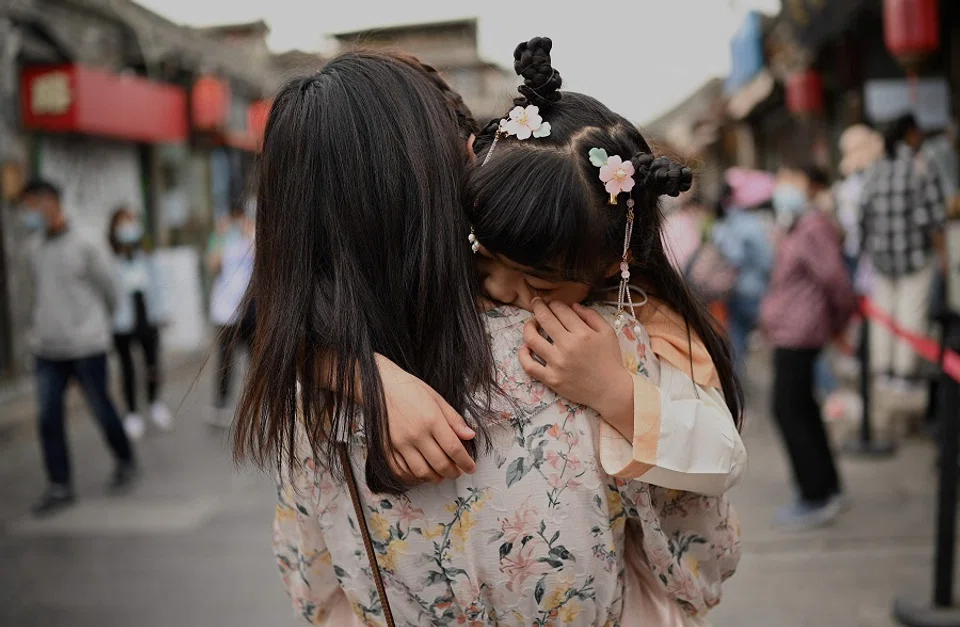Gender equality: The solution to China's declining birth rate
Providing better support for families to play effective co-parenting roles is more likely to improve birth rates than sending women back to the kitchen, says Chen Jing.

"Do you have a boyfriend? When do you plan to get married?"
No, this was not asked at a family gathering but at a work interview. My friend, hoping to find a job in Shanghai, was stumped by the question. She explained to the hiring manager that while she has a boyfriend, they have no plans of getting married yet. She stressed that family matters would not have an impact on her work.
The hiring manager immediately countered, "How can that be? You're not young anymore. Your parents will certainly want you to get married soon and have children right away. This project will roughly take three years. If you go on maternity leave during the crucial phase of the project, wouldn't the company need to hire someone to replace you?"
My friend was speechless. She lost a job opportunity just like that. Although the people around her told her she was better off not joining such a sexist company, this unpleasant experience has made her wary of job interviews and being asked questions about marriage and children. "I should just say that I want to stay single," she sighed.
Able and willing to give birth, but put off by penalties
Research shows that Chinese women are given a "motherhood penalty" (生育惩罚) for roughly two years. Worried that they would be discriminated against at the workplace, more women are choosing to marry later or even stay single and remain childless, in turn leading to a declining birth rate in China.

According to the national population census released on 11 May, over the past decade, China's population growth rate has declined to a record low in 60 years. A decline in the number of women of childbearing age and fertility rates means a further decline in birth rates in the next few years. This implies that China, which has enjoyed a demographic dividend for a long time, may face the challenges brought about by a shrinking population earlier than expected. The key to solving this problem lies in finding ways to encourage women to give birth to more children.
As female workers are now able to have two children, companies are more careful about hiring women with no kids or those with only one child.
At the press conference, the commissioner of the National Bureau of Statistics of China Ning Jizhe pointed out that China's total fertility rate (TFR) was 1.3 last year, meaning that each woman of childbearing age gave birth to an average of 1.3 children, which is already a low level. But the survey also revealed that women of childbearing age in China are willing to have an average of 1.8 children. Ning said that "the potential fertility will be released" if they are able to work on implementing good measures to support the parents.
Following the release of the census, there have been calls to liberalise restrictions on childbirth and to allow reproductive autonomy. However, even after China's universal two-child policy came into effect in 2016 (after doing away with the one-child policy), China's birth rate has not risen significantly. Thus, the effectiveness of further relaxing family planning policies remains questionable.
More support needed
An important reason why the two-child policy has not been very effective is that it has brought more losses than gains for mothers. As female workers are now able to have two children, companies are more careful about hiring women with no kids or those with only one child. Even in the case of female workers who already have two children, they are thought to spend more time and energy on their children to the detriment of their work. This hinders their career progression as a result. When I chatted with my Chinese friends, I discovered that the men are concerned about the increased costs of having two children, while the women worry additionally about encountering gender discrimination in the workplace.

While they traditionally took on the role of the caregiver, women nowadays are starting to pay more attention to their personal development after receiving a high level of education. As a result, their family and work roles are in conflict with each other, as directly reflected in the delayed childbearing age. Based on statistics, between 1990 and 2015, the average age of Chinese women giving birth to their first child has been delayed from 24.1 to 26.3, while the number of single women has risen to six million. Women with more well-established careers are also more unwilling to give birth.
If this trend continues, people are worried that Chinese women will only be less and less willing to have children. Does this mean that the birth rate can only go up if women are forced to return to the family realm?
In actual fact, a survey of Organisation for Economic Co-operation and Development (OECD) countries shows that the smaller the employment gap between males and females, the higher the fertility rate. Research also shows that a "U-shaped curve" describes the relationship between gender equality and fertility. More females entering the workforce does result in a decreased fertility rate, but as gender equality further improves, fertility rates gradually increase again.
Sweden, known to have the best gender equality ratings in the world, is also a country with one of the highest fertility rates in Europe.

Sweden, known to have the best gender equality ratings in the world, is also a country with one of the highest fertility rates in Europe. In this northern European country where nearly half of its parliament and government members are women, its TFR was 1.8 in 2019, which was only second to France's TFR of 1.9. In Iceland where the female employment rate exceeds 80%, its TFR also reached 1.7 in 2019.
Apart from protecting women's employment rights, northern European countries also provide various welfare incentives such as good education for children and other healthcare benefits that give women who wish to have children at different stages of life peace of mind. China is also moving towards this direction, and the duration of maternity leave in regions like Guangdong, Heilongjiang and so on have been extended to six months. However, preventing this benefit from being translated into increased labour costs for the company, and hence discrimination against women in the workplace, requires further guarantees and coordination by the government.
Extending the childcare leave of career women, helping them return to the workforce after childbirth, and providing them with childcare services are ways that help women maintain a balance between their family, career, and self-development, and are important factors that increase their willingness to have children. The current trend of Chinese women being reluctant to have children shows the initial results of promoting gender equality in this populous country, but also points to the fact that there is a long way to go.
Related: Is China facing a demographic crisis? | Can China reverse its population decline? | Chinese single women ponder love, marriage and freedom | China's rising property prices have serious social consequences | Chinese economics professor: Fathers are not inferior to mothers when it comes to parenting





